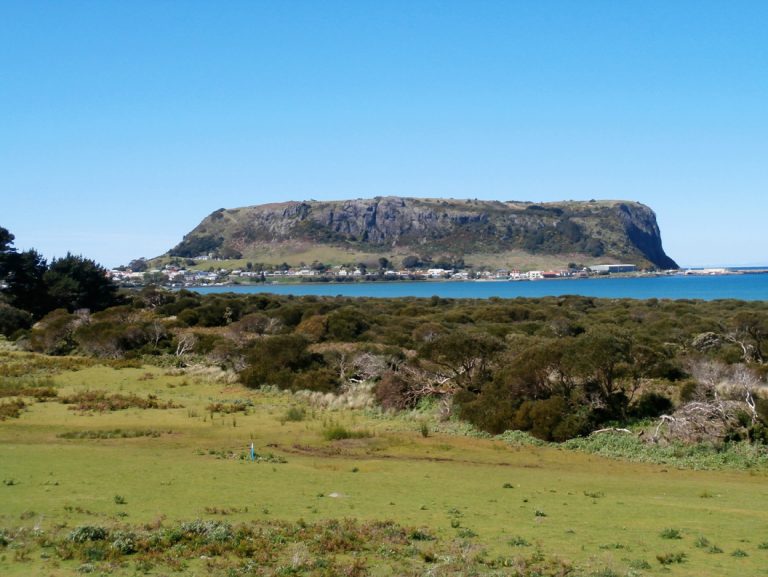JOHN McNAMEE DISCOVERS SOME WONDERS ON THE APPLE ISLE
It was almost three o’clock in the morning and the holiday park was shrouded in a mist that had drifted in across the Bass Strait.
The only noise came from a few night animals which still scurried around among the dew-covered camping sites.
The deep silence was broken only by the occasional squawk of a ground-nesting plover guarding her eggs in an almost endless vigil.
Suddenly, the early morning tranquillity is shattered by a far-off blast of a speeding freight train followed by the shrieking clangour of the flashing red lights of the railway crossing.

It was the overnight Burnie to Devonport freight train, powered by three massive diesel locomotives hauling up to sixty flat-bed wagons carrying shipping containers of all descriptions.
The crossing is only a few metres from the entrance to the normally sleepy Ulverstone holiday and camping site, situated on the spectacular north-west coast of Tasmania and the train’s super-bright headlights pierce the darkness throwing eerie shadows over the trees and buildings.
But nobody seems to mind the shock of the early morning invasion of their sleep… in fact next day we say to the neighbours in the nearby villa: “Did you hear the train early this morning, exciting isn’t it?” Someone else says: “That’s another lot of containers that won’t be clogging up our roads eh?”
And we all laugh and shake our heads, quite content in the knowledge that the mighty wheels of industry are still thundering along in this progressive part of the Tassie coastline…even at such ungodly hours.
The bulk freight-only rail service runs on a narrow gauge (1067mm, 3ft6ins) track several times throughout the day carrying the containers to the Devonport docks where they are on-shipped to Melbourne and Sydney.
The late afternoon service is usually greeted by a gaggle of kids and mums and dads crowding around the crossing and waving excitedly to the driver, high up in his lofty cabin.
It sounds strange but it’s one of the many little memories we take away from our week-long sojourn along this wonderful area on Tassie’s north coast.
We’re staying in a comfortable two-bedroom Family Villa at the Ulverstone holiday park to take part in the 16th Australian Masters Games. The athletics events are being staged a few kilometres away in picturesque Penguin, which boasts an international standard track and field stadium tucked away in a colourful bush setting just outside of town.

We’re blessed with beautiful weather all the time of our stay, only one light shower, but the frigid water of the ocean was only for the brave, or foolhardy.
Ulverstone itself is a convenient base for our competition efforts and our sightseeing between event days. With a town population of 11,000, Ulverstone is one of those places which have a lot of respect for their war dead and numerous well-kept parks around the area are dedicated to the fallen of all services and of both World Wars.
But the most spectacular sight is the clock tower in the centre of town which forms part of the Shrine of Remembrance completed in 1954.
Three massive shining columns representing the R.A.N., A.I.F and R.A.A.F soar up via a series of chain links to the laurel wreath suspended beneath the clock which during the day rings out a tinkling peal of bells denoting the hour and half hour and which can be heard over a wide area.
On top of the tower is the Torch of Remembrance which is lit up at night.
Later we head off to Penguin, named in the 1850s after the colonies of fairy penguins which frequented the local beach every night. In the middle of town is the eponymous statue, The Big Penguin, standing three metres high and erected to commemorate the town’s centenary in 1975.
The drive along the Ulverstone to Penguin road, which winds around rocky capes and rugged coves is one of the most picturesque in the area. Many visitors reckon the coastal road trip from Ulverstone all the way through the bustling port of Burnie to historic Stanley is equal only to Victoria’s Great Ocean Road.

You actually need to spend several days to visit most of the other great sights along this coastline but we were determined to spend some time in the township of Stanley.
Along the way, and after gazing in awe at the colourful tulip farms winding along the cliffside farms, we stop for coffee at the beautiful Boat Harbour settlement which is famous for its silvery-white sandy beaches and deep, crystal clear aquamarine waters
Stanley itself is breathtaking as it huddles under the vast bulk of the volcanic plug affectionately named The Nut. It was originally named Circular Head by Bass and Flinders when they discovered it in 1798 and rises to a height of 143 metres.
There’s a chair lift for the adventurous who want to climb up to the rock’s flat top but we’re content to stroll around the township and visit Stanley’s other famous landmark, the cottage of Joe Lyons, Tasmania’s only Prime Minister of Australia.
Lyons served as Premier of Tasmania from 1923 to 1928 and as Prime Minister from 1932 to 1939. His wife Dame Enid was the first woman to be elected to the House of Representatives and was Australia’s first woman Cabinet Minister.
Joe’s humble birthplace is a charming split paling cottage furnished in the Lyons’ era and houses a valuable collection of enlarged photographs of the life and times of their family.
Stanley was first settled as a harbour but gales and treacherous seas soon turned it into a graveyard for shipping and now only fishing trawlers tie up at its still-existing wharf.

The town also has a fascinating Discovery Museum nearby which features items of interest from the first days of settlement in 1858, marine history and artefacts and relics from ships.
Stanley boasts many wonderful pubs such as the Commercial Hotel and the Stanley Hotel and coffee shops offering mouth-watering delicacies and country-style meals.
Back at Ulverstone, we learn that another historic township, Sheffield, is only a short drive away too and worth a visit because of its famous murals, depicting the history of the place and scenes from its colonial past.
We’ve run out of time to visit the island’s most famous landmark, Cradle Mountain, but we’ve promised ourselves we’ll soon be back on Tassie soil and we’ll head straight there to that awesome national park, one of the most dramatic in Australia.
Main Picture: The massive bulk of The Nut, an ancient volcanic plug towers over the historic township of Stanley.





